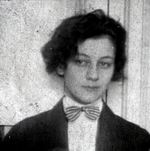|
 Hélène Akhvlediani (1901-1975) Hélène Akhvlediani (1901-1975)
Modernist artist, stage designer.
Born in Telavi in 1901.
Studies at Tbilisi N. Skliphosofsky Art
Studio; Travels to Moscow and gets impressed by Vrubel’s paintings.
In 1919 already participates in Georgian
artists exhibition.
In 1921 continues studying at Tbilisi Art
Academy in G. Gabashvili class. In 1922 she leaves for Italy for further
studies and travels to Rome, Milan, Florence and Venice for 6 months.
In 1924 begins studying at Académie Colarossi in Paris, where her main field of work – urban
landscapes – elaborates.
She makes the whole series of Parisian
views. It is also in Paris that a big graphic series of her up till now less
known Nude is created. Obviously, she never returns to it back in the Soviet
Georgia.
She is quite successful in Paris. Her oil
cityscapes are bought by collectors and artists including Paul Signac himself.
She participates in the exhibitions of “Paris
Independent Saloon” and “The Autumn
Saloon” as well as arranges personal exhibitions at the gallery “Quatre Chemin”.
In 1926-1927 she is invited to Holland to
arrange an exhibition but Akhvlediani sends her paintings and returns to
Georgia.
After returning to Tbilisi the
stage-director Kote Marjanishvili offers her to work in theatre. Stage design
becomes one of the leading spheres for Elene Akhvlediani. In 1928-1941 she
designs about 20 performances in various theatres.
In Georgia she mainly work in urban
landscapes of Tbilisi, Telavi, Kutaisi. However, Tbilisi occupies such a big place
in her work that her art is always associated with Tbilisi by professionals as
well as by amateurs.
This theme underwent certain and quite
obvious transformations during the decades from 1920es to 1970es and it could
be foreseen as the Soviet Realism put its demands to all the fields, branches
and genres of art.
Therefore, it can be said that her Parisian
cityscapes of 1920es and Tbilisi views of the second half of the 1920es are of
a prime significance among her works.
her “Utrillo-like” urban landscapes reveal how far she
was from the Avant-garde radicalism; on the contrary, like the representatives
of The Paris School she brings her
personal history into the art on the one hand (it is much revealed in the Nude
series of the Parisian period), and on the other she brings into being the
certain idea of “Eternity”. Akin to “Peintres
Maudits”, everyday and
ordinary urban environment is valued to her; the intimate, personalized but at
the same time as if substantialized the quarters, the places the streets-roads
where her life proceeds.
|